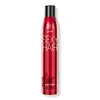What's inside
What's inside
 Benefits
Benefits

No benefits
 Concerns
Concerns

 Ingredients Side-by-side
Ingredients Side-by-side

Sd Alcohol 40-B
AstringentWater
Skin ConditioningVp/Va Copolymer
Isopropyl Alcohol
SolventPolysorbate 20
EmulsifyingParfum
MaskingCetrimonium Chloride
AntimicrobialPolyquaternium-11
Silicone Quaternium-3
Glycerin
HumectantTrideceth-12
EmulsifyingPolyquaternium-59
UV AbsorberCitrullus Lanatus Fruit Extract
Skin ConditioningLitchi Chinensis Fruit Extract
Skin ConditioningButylene Glycol
HumectantLeontopodium Alpinum Flower/Leaf Extract
Skin ConditioningPhenoxyethanol
PreservativeStyrax Benzoin Resin Extract
MaskingCitric Acid
BufferingPotassium Sorbate
PreservativeSodium Benzoate
MaskingLimonene
PerfumingHexyl Cinnamal
PerfumingLinalool
PerfumingCitral
PerfumingSd Alcohol 40-B, Water, Vp/Va Copolymer, Isopropyl Alcohol, Polysorbate 20, Parfum, Cetrimonium Chloride, Polyquaternium-11, Silicone Quaternium-3, Glycerin, Trideceth-12, Polyquaternium-59, Citrullus Lanatus Fruit Extract, Litchi Chinensis Fruit Extract, Butylene Glycol, Leontopodium Alpinum Flower/Leaf Extract, Phenoxyethanol, Styrax Benzoin Resin Extract, Citric Acid, Potassium Sorbate, Sodium Benzoate, Limonene, Hexyl Cinnamal, Linalool, Citral
Water
Skin ConditioningHydrofluorocarbon 152a
Vp/Va Copolymer
Dimethyl Ether
SolventIsopentane
SolventPvp
Emulsion StabilisingPEG-12 Dimethicone
Skin ConditioningPolysorbate 80
EmulsifyingCocamidopropyl Hydroxysultaine
CleansingOleth-20
CleansingButylether Hidroxypropil Sultaine
PPG-5-Ceteth-20
EmulsifyingCarbomer
Emulsion StabilisingDiazolidinyl Urea
PreservativeParfum
MaskingBenzyl Salicylate
PerfumingButylphenyl Methylpropional
PerfumingCitronellol
PerfumingEugenol
PerfumingGeraniol
PerfumingHexyl Cinnamal
PerfumingHydroxycitronellal
PerfumingHydroxyisohexyl 3-Cyclohexene Carboxaldehyde
MaskingLimonene
PerfumingSodium Hydroxide
BufferingBenzophenone-4
UV AbsorberTetrasodium EDTA
Tetrahydroxypropyl Ethylenediamine
Water, Hydrofluorocarbon 152a, Vp/Va Copolymer, Dimethyl Ether, Isopentane, Pvp, PEG-12 Dimethicone, Polysorbate 80, Cocamidopropyl Hydroxysultaine, Oleth-20, Butylether Hidroxypropil Sultaine, PPG-5-Ceteth-20, Carbomer, Diazolidinyl Urea, Parfum, Benzyl Salicylate, Butylphenyl Methylpropional, Citronellol, Eugenol, Geraniol, Hexyl Cinnamal, Hydroxycitronellal, Hydroxyisohexyl 3-Cyclohexene Carboxaldehyde, Limonene, Sodium Hydroxide, Benzophenone-4, Tetrasodium EDTA, Tetrahydroxypropyl Ethylenediamine
Ingredients Explained
These ingredients are found in both products.
Ingredients higher up in an ingredient list are typically present in a larger amount.
Hexyl Cinnamal is a fragrance ingredient with a similar scent to jasmine. It can be naturally found in chamomile essential oil.
This ingredient is a known EU allergen and may sensitize the skin. The EU requires this ingredient to be listed separately on an ingredients list.
Hexyl Cinnamal is not water soluble but is soluble in oils.
Learn more about Hexyl CinnamalLimonene is a fragrance that adds scent and taste to a formulation.
It's found in the peel oil of citrus fruits and other plants such as lavender and eucalyptus. The scent of limonene is generally described as "sweet citrus".
Limonene acts as an antioxidant, meaning it helps neutralize free radicals.
When exposed to air, oxidized limonene may sensitize the skin. Because of this, limonene is often avoided by people with sensitive skin.
The term 'fragrance' is not regulated in many countries. In many cases, it is up to the brand to define this term. For instance, many brands choose to label themselves as "fragrance-free" because they are not using synthetic fragrances. However, their products may still contain ingredients such as essential oils that are considered a fragrance.
Learn more about LimoneneParfum is a catch-all term for an ingredient or more that is used to give a scent to products.
Also called "fragrance", this ingredient can be a blend of hundreds of chemicals or plant oils. This means every product with "fragrance" or "parfum" in the ingredients list is a different mixture.
For instance, Habanolide is a proprietary trade name for a specific aroma chemical. When used as a fragrance ingredient in cosmetics, most aroma chemicals fall under the broad labeling category of “FRAGRANCE” or “PARFUM” according to EU and US regulations.
The term 'parfum' or 'fragrance' is not regulated in many countries. In many cases, it is up to the brand to define this term.
For instance, many brands choose to label themselves as "fragrance-free" because they are not using synthetic fragrances. However, their products may still contain ingredients such as essential oils that are considered a fragrance by INCI standards.
One example is Calendula flower extract. Calendula is an essential oil that still imparts a scent or 'fragrance'.
Depending on the blend, the ingredients in the mixture can cause allergies and sensitivities on the skin. Some ingredients that are known EU allergens include linalool and citronellol.
Parfum can also be used to mask or cover an unpleasant scent.
The bottom line is: not all fragrances/parfum/ingredients are created equally. If you are worried about fragrances, we recommend taking a closer look at an ingredient. And of course, we always recommend speaking with a professional.
Learn more about ParfumWe don't have a description for Vp/Va Copolymer yet.
Water. It's the most common cosmetic ingredient of all. You'll usually see it at the top of ingredient lists, meaning that it makes up the largest part of the product.
So why is it so popular? Water most often acts as a solvent - this means that it helps dissolve other ingredients into the formulation.
You'll also recognize water as that liquid we all need to stay alive. If you see this, drink a glass of water. Stay hydrated!
Learn more about Water